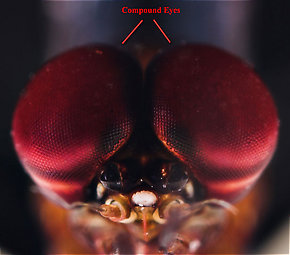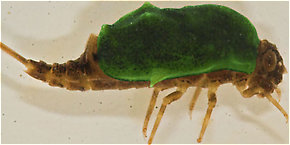Blog & Latest Updates
Fly Fishing Articles
Insects by Common Name


Mysis Shrimp
This common name refers to only one order.
Arthropod Order Mysida
These are pretty much always called Mysis Shrimp.
Mysis shrimp also commonly known as opossum shrimp for the way they carry their broods, can be important to anglers as a curious bi-product of fisheries management practices. Fish and Game departments looking for a way to supplement the diets of planted kokanee salmon introduced these species from the Far North decades ago into many of the newly formed reservoirs. While not providing angling opportunities in the impoundments, they are often trapped in the dam's turbines and flushed down the tailwaters by the millions to feed the waiting trout. Their stunned or dead state makes them easy pickings. When these events occur the fish will really focus on them.
Mysida are not true shrimp and their appearance is unique. The species most commonly planted are virtually crystal clear transparant and they are more nymph shaped than shrimp shaped. Their legs are toward the front and they have a carapace (Carapace: A hard, protective shell on the back of an animal. In mayflies, this refers to the enlarged section of the mesonotum which forms the "humps" of Baetisca nymphs.) that covers the head and thoracic (Thorax: The thorax is the middle part of an insect's body, in between the abdomen and the head, and to which the legs and wings are attached.) segments. They also have appendages off the last abdominal segment that could be mistaken for tails. They have dark compound eyes ( Compound eye: The eyes of many arthropods, including insects and crustaceans, are composed of anywhere from 12 to 1,000 facets called ommatidia. These are called compound eyes.).
Compound eye: The eyes of many arthropods, including insects and crustaceans, are composed of anywhere from 12 to 1,000 facets called ommatidia. These are called compound eyes.).
Mysida are not true shrimp and their appearance is unique. The species most commonly planted are virtually crystal clear transparant and they are more nymph shaped than shrimp shaped. Their legs are toward the front and they have a carapace (Carapace: A hard, protective shell on the back of an animal. In mayflies, this refers to the enlarged section of the mesonotum which forms the "humps" of Baetisca nymphs.) that covers the head and thoracic (Thorax: The thorax is the middle part of an insect's body, in between the abdomen and the head, and to which the legs and wings are attached.) segments. They also have appendages off the last abdominal segment that could be mistaken for tails. They have dark compound eyes (

The compound eyes of a male Isonychia bicolor mayfly spinner.
Top 10 Fly Hatches
Top Gift Shop Designs
Eat mayflies.
Top Insect Specimens
Miscellaneous Sites
Troutnut.com is copyright © 2004-2024 Jason
Neuswanger (email Jason). See my FAQ for information about use of my images.
 privacy policy
privacy policy

